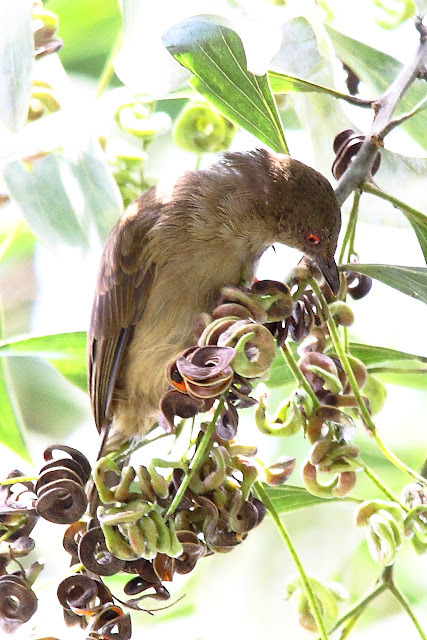White-breasted Waterhens are the most common of the Rail family in Malaysia, often heard before they are seen. Their loud quarrelsome calls sound like their Malay name, Ruak Ruak. They are more vocal at dawn and dusk.
White-breasted Waterhens eat mainly seeds, insects and small fish. They also nibble on worms and small snails; and snack on shoots and roots of marsh plants. They forage on the ground, pecking at titbits in chicken-like movements, hence their other Malay name: Ayam Ayam. Their enormous feet, constantly flicking tails and inquisitive nature make them very amusing birds to observe.
They also often forage above ground, in low bushes and small trees, but their long toes make them rather clumsy among the branches. Their slender body allows them to quickly and quietly slip through the undergrowth.
In Malaysia, White-breasted Waterhens can be seen stepping on lotus leaves searching for titbits. But inevitably, the leaf they are on slowly sinks. They then step off to the next leaf. Although they are associated with water and do swim, they are not particularly good swimmers.
White-breasted Waterhens forage alone or in pairs. They are active during the day. When alarmed, may fly or run into dense undergrowth, dashing in with their heads down. They roost in low bushes and trees at night.
Breeding: White-breasted Waterhens breed throughout the year. They nest amongst reeds, tall grass or dense undergrowth in both wet and dry habitats. Made about 1-2m above ground, the nest is a shallow cup-shaped pad of twigs, creeper stems or leaves. Or made out of bent over or interlaced tall grass stems topped with a thin lining of grass or weedy materials. Sometimes, it is roofed by surrounding plants.
4-9 eggs are laid. The eggs are dull brownish-white/grey with reddish brown spots and marks. Both parents incubate (20 days). The chicks are black and fluffy and leave the nest soon after hatching. Both parents care for them, and they may be seen running alongside the parents.
White-breasted Waterhens prefer habitats with dense undergrowth near water both brackish and freshwater. They are quite common in mangroves, marshes, reedbeds to grasslands and cultivated areas (ricefields, orchards, gardens, parks). They often "commute" between suitable habitats by using man-made water channels.
Migration: Some White-breasted Waterhens that breed in the north may migrate south and mix with local residents. Northern birds tend to be larger.
Status and threats: White-breasted Waterhens have adapted well to human activity and are not endangered. However, they are sometimes still hunted as food, and occasionally get run over by cars.
Location: Fraser Hill Date: 30.10.2011
Drongos are a birds with quite a few distinctive features. Most notably are the Racquet-tailed species with the long streamers extending out from their fairly long tail. Those without streamers have the tail -forked. Next, these are birds with loud calls and in metallic tone. When they are around, you just cannot miss their presence, the loud calls in unique tones are repeated in close frequencies. Lastly, another general feature of these birds, is their glossy dark blue colored feathers.
Drongos are insect-eating birds. Some are found in the deep forest but most of them found at forest edge with human traffic. Their legs are short and when perched maintains an upright position. whilst perched. They too remain in the same perch for long time, behaving like Shrikes. Most of the time their prey are in trees away from the ground.
 |
| litle green pegion. Location: DPP, Dengkil. |








No comments:
Post a Comment